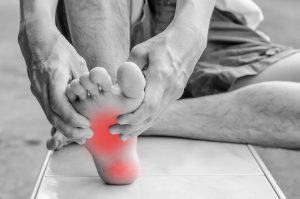Fun fact: the human foot is made up of over 100 moving parts. This is inclusive of bones, muscles, tendons, and ligaments that allow the foot to balance the body’s weight.
But because of this complex anatomy, human feet are susceptible to many diseases caused by various agents. To have healthy feet, you need to know the signs, symptoms, and causes of some of the most common foot problems.
Read on to find out more.
Quick Navigation
1. Athlete’s Foot
Tinea Pedis, commonly known as Athlete’s Foot, is a foot disease in humans caused by fungal infection. The fungus mostly affects the spaces between the toes but can spread to other areas, such as hands and groins.
There are three major types of athlete’s foot: interdigital, moccasin, and vesicular. However, they’re all characterized by similar symptoms which range from itching, cracking, and peeling of the affected area.
To prevent this foot problem, it’s advisable to keep your feet clean and dry to discourage the growth of the fungus. You can also make good use of the anti-fungal creams for treatment.
2. Bunions
A bunion is a painful bony bump that develops at the big toe joint. In most cases, the bump develops as a result of wearing ill-fitting shoes which put pressure on the joint.
Additionally, if your family has a history of bunions, you’re at a higher risk of getting bunions.
To avoid this painful condition, wear low-heeled fitting shoes. If the bunion has already developed, use a bunion pad to protect it from extra pressure. For extreme cases, you may need correctional surgery on the affected toe.
3. Ingrown Toenail
An ingrown toenail occurs when the corners of your toenails start to grow deep into the surrounding tissues. This often leads to swelling, pain, and redness of the affected toe.
The condition can be caused by either wearing poorly fitting shoes or a genetic disorder.
Cutting your toenails straight across, rather than in a rounded pattern, is one of the easiest ways to prevent an ingrown toenail. Additionally, wash your feet with antibacterial soap and wear sandals which are marketed as being friendly towards bunions and other foot ailments would greatly help.
4. Plantar Fasciitis
Plantar Fasciitis is caused by inflammation of the connective tissue that rests at the bottom of the foot. Patients will often complain of pain at the bottom of the heel which explains why it’s confused with heel spurs.
It’s mainly caused by strain or injury on the foot’s connective tissue, improper footwear, or walking on hard surfaces. The pain can be so severe that you may have trouble moving your feet on your own, and may require urgent care by a professional.
To ease the pain caused by plantar fasciitis, you can do stretch exercises, ice the affected area, wear orthopedic shoes, or use prescribed anti-inflammatory drugs.
5. Heel Spur
A heel spur is caused by the deposition of calcium on the underside of the heel bone. A patient may start experiencing pain and inflammation around the heel area.
This condition is caused by a number of factors, including arthritis, obesity, and ill-fitting shoes. Over-stretching or straining the muscle around the heel can also contribute to heel spurs.
Prescribed inflammatory drugs and injections are used to relieve the pain of the patient.
Prevent Common Foot Problems By Wearing the Right Shoes
Now that you’re familiar with the causes of common foot problems, make sure you adopt the preventive measures discussed. Also, consult a qualified medical professional as soon as you develop any of the foot problems outlined above.
Check out our shoe review articles to find the best pair for your foot condition.

